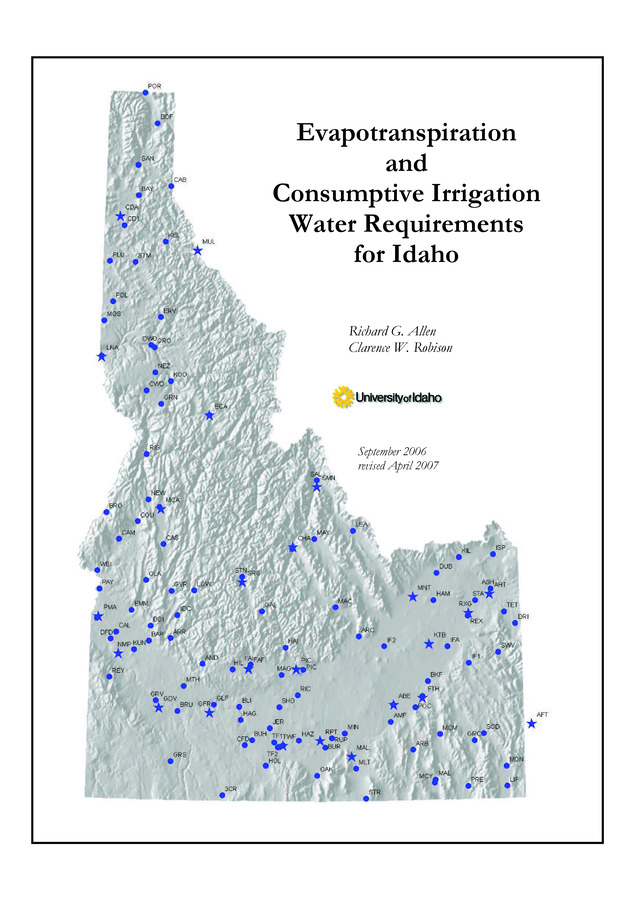PDF
Evapotranspiration and consumptive irrigation water requirements for Idaho. Item Info
- Title:
- Evapotranspiration and consumptive irrigation water requirements for Idaho.
- Authors:
- Allen, Richard G.; Robison, Clarence W.
- Date:
- 2007-04
- Description:
- Evapotranspiration (ET) is the primary component of irrigation water requirements for agricultural crops and landscapes. ET is the combined process by which water is converted from liquid or solid forms via evaporation from soil and wet plant surfaces and via evaporation of water from within plant tissue. The latter process is known as transpiration. ET can be expressed as the energy consumed as latent heat energy per unit area or as the equivalent depth of evaporated water. Units for ET are typically mm t-1 where t denotes a time unit (hour, day, month, growing season, or year). Quantification of ET is required to design and size irrigation system components, for operating irrigation and water resources systems, and for conducting water balances. Rates of ET are strongly affected by weather and, during the course of a growing season, by the type of vegetation and availability of water. Evapotranspiration and net irrigation water requirements have been computed for this report on a daily, monthly and annual basis for 123 weather station locations across Idaho for available periods of record. These calculations supersede calculations previously made for Idaho by Allen and Brockway (1983) and use updated methods for calculating both reference evapotranspiration (ETr) and crop coefficients (Kc). The ET estimates represent a wide range of agricultural crops grown in Idaho and ET estimates have been made for a number of native plant systems including wetlands, rangeland, and riparian trees. Estimates have been made for three types of open water surfaces ranging from deep reservoirs to small farm ponds. The ET and net irrigation water requirement calculations are intended for use in design and management of irrigation systems, for water rights management and consumptive water rights transfers and for hydrologic studies. ET calculations have been made for all times during the calendar year including winter to provide design and operation information for managing land application of agriculture, food processing and other waste streams. The weather stations evaluated include 107 National Weather Service (NWS) cooperative stations measuring primarily air temperature and precipitation and 16 AgriMet agricultural weather stations. The AgriMet stations measure a full complement of weather affecting evapotranspiration and are located primarily in the southern part of the state. Monthly wind summaries from the AgriMet stations and some airport locations in central and northern Idaho were used to parameterize the ETr calculations. Calculations have been made through December 31, 2004 for NWS stations and through December 31, 2005 for AgriMet stations. September 2006, revised April 2007.
- Subjects:
- irrigation water supply evapotranspiration water management economic efficiency computer models
- Source:
- Idaho Water Resources Research Institute, University of Idaho
- Identifier:
- IWRRI Number 200703
- Publisher:
- Idaho Water Resources Research Institute, University of Idaho
- Contributing Institution:
- University of Idaho
- Type:
- Text
- Format:
- application/pdf
- Cataloger:
- KIT
- Language:
- eng
Source
- Preferred Citation:
- "Evapotranspiration and consumptive irrigation water requirements for Idaho.", Idaho Waters Digital Library, University of Idaho Library Digital Collections, https://www.lib.uidaho.edu/digital/iwdl/items/iwdl-200703.html
Rights
- Rights:
- In copyright, educational use permitted. Educational use includes non-commercial reproduction of text and images in materials for teaching and research purposes. For other contexts beyond fair use, including digital reproduction, please contact the University of Idaho Library Special Collections and Archives Department at libspec@uidaho.edu. The University of Idaho Library is not liable for any violations of the law by users.
- Standardized Rights:
- http://rightsstatements.org/vocab/InC-EDU/1.0/

